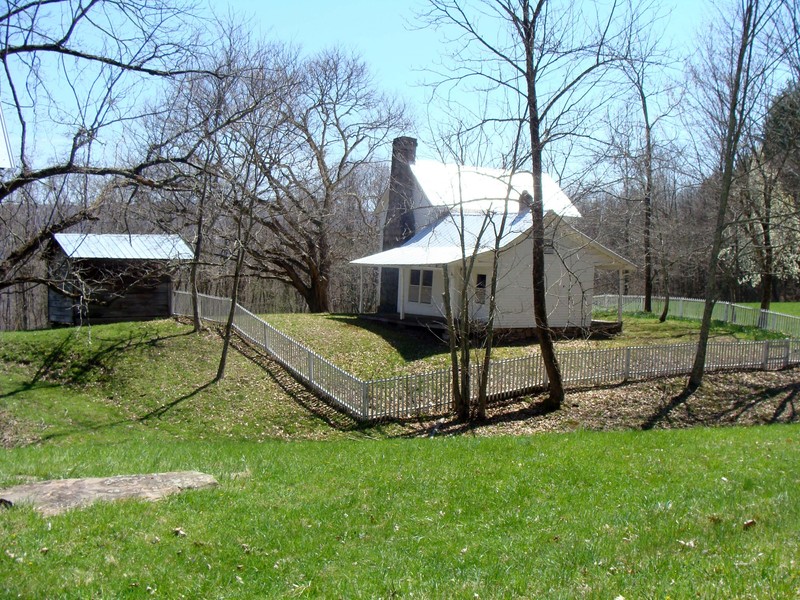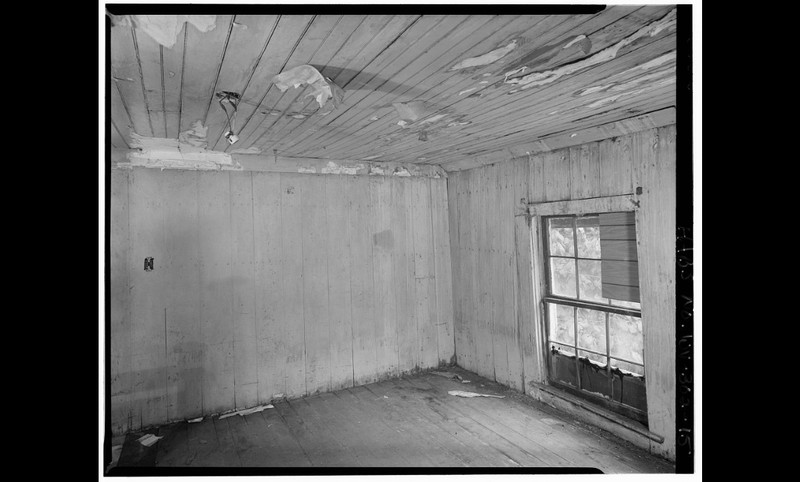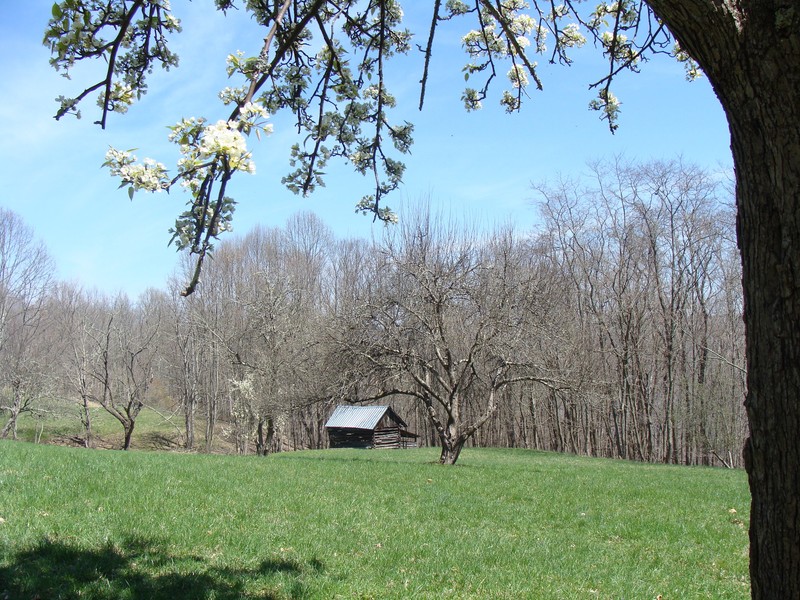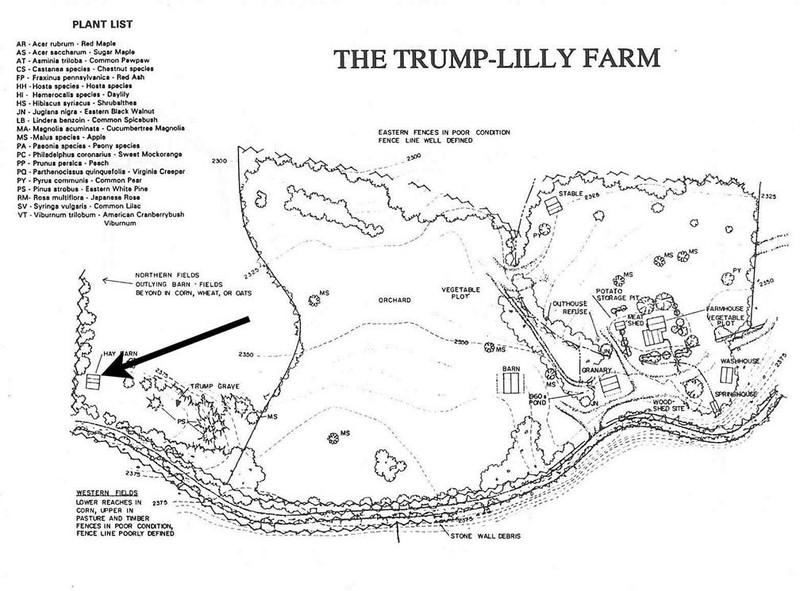This entry includes a walking tour! Take the tour.
Introduction
Text-to-speech Audio
The Trump-Lilly Farm is a quintessential example of subsistence farming in West Virginia. The farm is named for two families that occupied the homestead between 1888 and the latter half of the twentieth century. Life was difficult on the farm. The families grew crops, raised animals, hunted local game, and foraged whatever they could. Almost all of the buildings erected to serve the farm are still standing in their original condition, a contrast to many other farm buildings in Appalachia, which were demolished or modernized. This property is now owned by the National Park Service, which has stabilized and preserved the buildings and grounds as a space to visit and see what frontier life was like.
Images
The main farmhouse on the homestead.

The interior of the farmhouse is beginning to deteriorate, as can be seen in this photo from a Historic American Buildings Survey of the property.

A view across a field at the farm. The tree in the middle ground is an apple tree, a remnant of the orchard that once fruited here.

Map of the Trump-Lilly Farm.

Backstory and Context
Text-to-speech Audio
The Trump-Lilly Farm traces its roots back to Samuel L. Hopkins and Alexander Stuart. These two men were both land grant recipients in the earliest days of the United States. In the early nineteenth century — probably around 1810 or 1815 — Peter Davis purchased several hundred acres of land from Hopkins and Stuart and settled in the area. Davis later sold 150 acres of his land to William Richmond. It is possible Richmond utilized the land for some crops or livestock grazing, but he was more focused on the small town of Richmond Falls. There, he built a grist mill, post office, and general store. Despite Richmond’s contributions, the town is now known as Sandstone Falls. Davis also acquired some additional land, bringing the total acreage of what would become the Trump-Lilly farm to 202.
An aging Davis gifted the plot of land at the top of Sewell Knob to his daughter, Mary E. Trump, in 1888. Mary Trump and her husband, Richard Trump, established the first true homestead at Trump-Lilly Farm, though they did not occupy it long. Between 1905 and 1912, the farm changed hands several times before finally being purchased by Aden J. Lilly. Lilly and his family quickly began improving and expanding the farm so that it could serve all his subsistence needs. Within a few years, the farm had reached its current state, which remains frozen in time for visitors to experience.
Life was difficult at Trump-Lilly Farm. In contrast to the large farms in bordering Greenbrier County, The Lilly family’s homestead had no luxury of growing cash crops. Everything grown, harvested, hunted, or gathered was consumed directly or reserved for essential trade. A grove of chestnut and oak trees provided building and heating materials. Crops for livestock consumption were grown in larger fields while smaller plots were used to cultivate potatoes, onions, cabbage, beans, and turnips. A small apple orchard was also present. Sheep raised on the homestead served two purposes: providing wool for vestments and lambs to sell in order to pay taxes. Chickens, cows, and pigs were also raised in smaller numbers, with only the lattermost being slaughtered for meat. Finally, foraging edible plants from the forest and hunting small game, such as turkeys and rabbits, helped round out the food supplies on the farm.
Despite the difficult life led by the Lilly family, their experience should not be understood as joyless or isolated. On the contrary, there were plenty of opportunities for enjoyment and community was a cornerstone of existence. The Lilly children were relatively well educated and always had ample textbooks and learning materials. A battery operated Croby radio allowed the family to stay abreast with current events and leisure programming. An organ case piano was used to play music. The Lillys attended church every Sunday and were active members in the congregation. Additionally, the local community was relatively tight-knit. Farmers in the area helped each other harvest crops, drive livestock, and even share grist and cane mills.
Unlike most historic homesteads and subsistence farms in southern West Virginia, the Trump-Lilly farm was not adapted for modern farming techniques. Aden Lilly sold the land to his son, Oba Lilly, in 1963, but Oba did not live at the farm and visited only rarely. Oba later resold the farm to David Rosenberger, who used it as a vacation rental. In 1989, Rosenberger sold the Trump-Lilly Farm to its current owner, the National Park Service. The National Park Service maintains the site as a quintessential example of subsistence farming in West Virginia. Of the structures erected by the Lilly family on the site, all but three of them remain. A woodshed, chicken coop, and pig pen have been lost to time, but many other buildings remain, lending a remarkable degree of historical integrity to the site.
Sources
Cristy. Experience Subsistence Farming’s Harsh Reality At Two New River Gorge Homestead Museums In West Virginia, Only In Your State. April 9th 2021. Accessed June 2nd 2021. https://www.onlyinyourstate.com/west-virginia/subsistence-farms-wv/.
Mansfield, Haynes. Homesteading Before It Was Cool | Visit Trump-Lilly Farmstead, Life Appalachia. January 1st 2014. Accessed June 2nd 2021. http://lifeappalachia.com/homesteading-before-it-was-cool-the-trump-lilly-farmstead/.
McGowan, Leigh. Trump-Lilly Farm, National Register of Historic Places. January 31st 1990. Accessed June 2nd 2021. http://www.wvculture.org/shpo/nr/pdf/raleigh/90001640.pdf.
Stahlgren, Lori et al. Historical Archaeological Survey: New River Gorge National River and Gauley River National Recreation Area. Lexington, KY. Kentucky Archaeological Survey, 2007.
Trump-Lilly Farm, Hinton, Summers County, WV, Historic American Buildings Survey. Accessed June 2nd 2021. https://www.loc.gov/resource/hhh.wv0531.photos?st=gallery&c=160.
Trump-Lilly Farm, National Park Service. January 26th 2021. Accessed June 2nd 2021. https://www.nps.gov/neri/learn/historyculture/trump-lilly-farm.htm.
Trump-Lilly Farm Walking Tour, National Park Service. September 24th 2020. Accessed June 2nd 2021. https://www.nps.gov/neri/learn/historyculture/trump-lilly-farm-walking-tour.htm.
Bieri, Dave. “Trump-Lilly Farm.” National Park Service. Accessed June 2nd, 2021. https://www.nps.gov/media/photo/gallery-item.htm?pg=3872031&id=2825eb49-7694-4908-a308-ca8050ec7c89&gid=44620784-BF7C-465C-8522-080783060242.
“Trump-Lilly Farm, Hinton, Summers County, WV.” Library of Congress. Accessed June 2nd, 2021. https://www.loc.gov/resource/hhh.wv0531.photos/?sp=16.
Bieri, Dave. “A View From the Farm.” National Park Service. Accessed June 2nd, 2021. https://www.nps.gov/media/photo/gallery-item.htm?pg=3872031&id=613eb3a7-ac3c-404a-ae31-0423616091c9&gid=44620784-BF7C-465C-8522-080783060242.
National Park Service. Accessed June 2nd, 2021. https://www.nps.gov/neri/learn/historyculture/trump-lilly-farm-walking-tour.htm.
